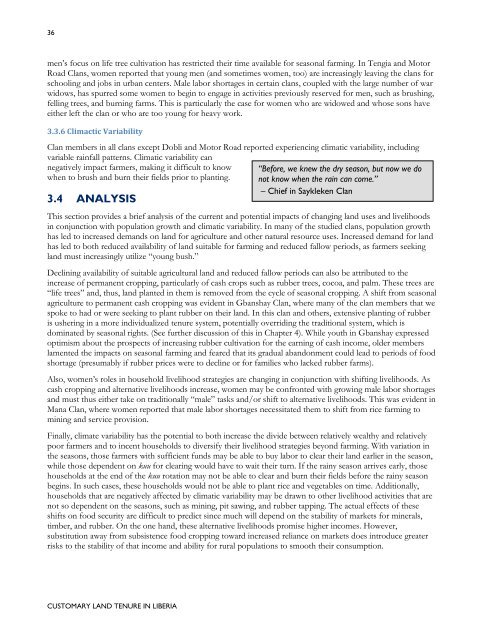Customary Land Tenure in Liberia - Land Tenure and Property ...
Customary Land Tenure in Liberia - Land Tenure and Property ...
Customary Land Tenure in Liberia - Land Tenure and Property ...
Create successful ePaper yourself
Turn your PDF publications into a flip-book with our unique Google optimized e-Paper software.
36<br />
men‟s focus on life tree cultivation has restricted their time available for seasonal farm<strong>in</strong>g. In Tengia <strong>and</strong> Motor<br />
Road Clans, women reported that young men (<strong>and</strong> sometimes women, too) are <strong>in</strong>creas<strong>in</strong>gly leav<strong>in</strong>g the clans for<br />
school<strong>in</strong>g <strong>and</strong> jobs <strong>in</strong> urban centers. Male labor shortages <strong>in</strong> certa<strong>in</strong> clans, coupled with the large number of war<br />
widows, has spurred some women to beg<strong>in</strong> to engage <strong>in</strong> activities previously reserved for men, such as brush<strong>in</strong>g,<br />
fell<strong>in</strong>g trees, <strong>and</strong> burn<strong>in</strong>g farms. This is particularly the case for women who are widowed <strong>and</strong> whose sons have<br />
either left the clan or who are too young for heavy work.<br />
3.3.6 Climactic Variability<br />
Clan members <strong>in</strong> all clans except Dobli <strong>and</strong> Motor Road reported experienc<strong>in</strong>g climatic variability, <strong>in</strong>clud<strong>in</strong>g<br />
variable ra<strong>in</strong>fall patterns. Climatic variability can<br />
negatively impact farmers, mak<strong>in</strong>g it difficult to know “Before, we knew the dry season, but now we do<br />
when to brush <strong>and</strong> burn their fields prior to plant<strong>in</strong>g. not know when the ra<strong>in</strong> can come.”<br />
– Chief <strong>in</strong> Saykleken Clan<br />
3.4 ANALYSIS<br />
This section provides a brief analysis of the current <strong>and</strong> potential impacts of chang<strong>in</strong>g l<strong>and</strong> uses <strong>and</strong> livelihoods<br />
<strong>in</strong> conjunction with population growth <strong>and</strong> climatic variability. In many of the studied clans, population growth<br />
has led to <strong>in</strong>creased dem<strong>and</strong>s on l<strong>and</strong> for agriculture <strong>and</strong> other natural resource uses. Increased dem<strong>and</strong> for l<strong>and</strong><br />
has led to both reduced availability of l<strong>and</strong> suitable for farm<strong>in</strong>g <strong>and</strong> reduced fallow periods, as farmers seek<strong>in</strong>g<br />
l<strong>and</strong> must <strong>in</strong>creas<strong>in</strong>gly utilize “young bush.”<br />
Decl<strong>in</strong><strong>in</strong>g availability of suitable agricultural l<strong>and</strong> <strong>and</strong> reduced fallow periods can also be attributed to the<br />
<strong>in</strong>crease of permanent cropp<strong>in</strong>g, particularly of cash crops such as rubber trees, cocoa, <strong>and</strong> palm. These trees are<br />
“life trees” <strong>and</strong>, thus, l<strong>and</strong> planted <strong>in</strong> them is removed from the cycle of seasonal cropp<strong>in</strong>g. A shift from seasonal<br />
agriculture to permanent cash cropp<strong>in</strong>g was evident <strong>in</strong> Gbanshay Clan, where many of the clan members that we<br />
spoke to had or were seek<strong>in</strong>g to plant rubber on their l<strong>and</strong>. In this clan <strong>and</strong> others, extensive plant<strong>in</strong>g of rubber<br />
is usher<strong>in</strong>g <strong>in</strong> a more <strong>in</strong>dividualized tenure system, potentially overrid<strong>in</strong>g the traditional system, which is<br />
dom<strong>in</strong>ated by seasonal rights. (See further discussion of this <strong>in</strong> Chapter 4). While youth <strong>in</strong> Gbanshay expressed<br />
optimism about the prospects of <strong>in</strong>creas<strong>in</strong>g rubber cultivation for the earn<strong>in</strong>g of cash <strong>in</strong>come, older members<br />
lamented the impacts on seasonal farm<strong>in</strong>g <strong>and</strong> feared that its gradual ab<strong>and</strong>onment could lead to periods of food<br />
shortage (presumably if rubber prices were to decl<strong>in</strong>e or for families who lacked rubber farms).<br />
Also, women‟s roles <strong>in</strong> household livelihood strategies are chang<strong>in</strong>g <strong>in</strong> conjunction with shift<strong>in</strong>g livelihoods. As<br />
cash cropp<strong>in</strong>g <strong>and</strong> alternative livelihoods <strong>in</strong>crease, women may be confronted with grow<strong>in</strong>g male labor shortages<br />
<strong>and</strong> must thus either take on traditionally “male” tasks <strong>and</strong>/or shift to alternative livelihoods. This was evident <strong>in</strong><br />
Mana Clan, where women reported that male labor shortages necessitated them to shift from rice farm<strong>in</strong>g to<br />
m<strong>in</strong><strong>in</strong>g <strong>and</strong> service provision.<br />
F<strong>in</strong>ally, climate variability has the potential to both <strong>in</strong>crease the divide between relatively wealthy <strong>and</strong> relatively<br />
poor farmers <strong>and</strong> to <strong>in</strong>cent households to diversify their livelihood strategies beyond farm<strong>in</strong>g. With variation <strong>in</strong><br />
the seasons, those farmers with sufficient funds may be able to buy labor to clear their l<strong>and</strong> earlier <strong>in</strong> the season,<br />
while those dependent on kuu for clear<strong>in</strong>g would have to wait their turn. If the ra<strong>in</strong>y season arrives early, those<br />
households at the end of the kuu rotation may not be able to clear <strong>and</strong> burn their fields before the ra<strong>in</strong>y season<br />
beg<strong>in</strong>s. In such cases, these households would not be able to plant rice <strong>and</strong> vegetables on time. Additionally,<br />
households that are negatively affected by climatic variability may be drawn to other livelihood activities that are<br />
not so dependent on the seasons, such as m<strong>in</strong><strong>in</strong>g, pit saw<strong>in</strong>g, <strong>and</strong> rubber tapp<strong>in</strong>g. The actual effects of these<br />
shifts on food security are difficult to predict s<strong>in</strong>ce much will depend on the stability of markets for m<strong>in</strong>erals,<br />
timber, <strong>and</strong> rubber. On the one h<strong>and</strong>, these alternative livelihoods promise higher <strong>in</strong>comes. However,<br />
substitution away from subsistence food cropp<strong>in</strong>g toward <strong>in</strong>creased reliance on markets does <strong>in</strong>troduce greater<br />
risks to the stability of that <strong>in</strong>come <strong>and</strong> ability for rural populations to smooth their consumption.<br />
CUSTOMARY LAND TENURE IN LIBERIA

















